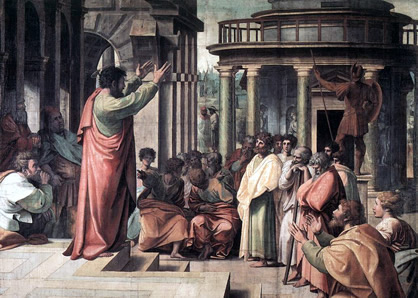Thyatira (Akhisar) Acts 16:14, Rev. 1:11;2:18-24
Thyatira was the fourth of the seven churches of Asia Minor to
receive an epistle from the St. John (Rev. 2:18-29). An important
trade center particularly for the textile industry of Hellenistic
and Roman times, the city lay along a low lying corridor that
followed a north south river bed connecting the Caicus and Hermes
River beds (Pergamum - Smyrna, Laodicea Road). Though the city
existed earlier, it reached notoriety when reconstructed by Seleucus
Nicator about 300 BC.

It was said that while he designed the city, he was informed of the
birth of his daughter. He name the city after the news (thygater is
Greek for daughter). It was a cultic center to Apollo (the sun god),
and apparent home of the wealthy trade guilds. It was for centuries
a frontier fort, first for the western edge of Seleucus I or Syrias
territory, then the eastern frontier of the Pergamene Kingdom. It
passed from the hands of Pergamon to Rome in 133 BCE.
The city was wealthy in ancient times, with its gentle rolling hills
and fertile valleys. Ramsey expressed that the connection with this
inland road was what made Pergamon important, so it gave careful
attention to the cities that gave free course to the trade industry.
It had a garrison maintained there (first Seleucids, then Pergamene,
then Roman). Ramsey notes that The condition of Thyatira was the best measure of the power of Pergamum.
It was considered by some ancients to be a city of Mysia, but to
others a city of Lydia.
condition of Thyatira was the best measure of the power of Pergamum.
It was considered by some ancients to be a city of Mysia, but to
others a city of Lydia.
The combination of a low plateau for an Acropolis and the sloping
valley surrounding it, gave an impression of the city as more
cosmopolitan and open, as opposed to the more austere cliffs at
Pergamum. The church at Thyatira, visited by St. Paul (Acts 19:10)
and represented by a convert who was away doing business in Philippi
(Lydia, cp. Acts 16:14) was also more open to heresy.
The letter of St. John to the church suggests that her openess and
gentleness in the face of heresy (Jezebel and Nicolaitines) was her
downfall (Rev. 2:18-23). About 150 AD, Montanus began a cult practice from Thyatira, claiming his prophetesses spoke with
the voice of the Holy Spirit (hence, Montanism). The city was
wealthy, but did not reach its zenith until the C2nd CE.
cult practice from Thyatira, claiming his prophetesses spoke with
the voice of the Holy Spirit (hence, Montanism). The city was
wealthy, but did not reach its zenith until the C2nd CE.
The trade guilds that flourished there included wool workers,
garment workers, linen workers, leather workers, dyers (purple),
bakers, potters, slave dealers and bronze smiths. Each guild was
accompanied by its patron gods and in many cases included immoral
practices in participation with the guild members. A faithful
Christian may have found it difficult to live his faith, as well as
practice his craft.
Points of interest for the visitor today include the ruins of a
temple. Thyatira's ancient ruins
 were
left untouched until Rustem Duyuran began to excavate the site from
1968 to 1971. Numerous inscriptions were found (21 sent to Manisa
Museum), along with the location of the colonnaded stoa and other
public buildings.
were
left untouched until Rustem Duyuran began to excavate the site from
1968 to 1971. Numerous inscriptions were found (21 sent to Manisa
Museum), along with the location of the colonnaded stoa and other
public buildings.
Biblical Sites in Turkey List


